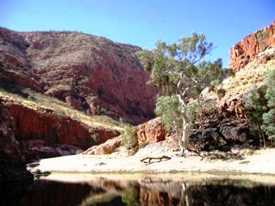-
Alice Springs Cultural Precinct
The Alice Springs Cultural
Precinct, also known as the Araluen Cultural Precinct is where many
of the best cultural and historical experiences can be found in the
precinct; that includes the natural history of the territory,
performing and visual arts, recent European settlements and
Aboriginal art and culture. Within its jurisdiction, you can find;
the Araluen Arts Center, the Yeperenye sculpture, the Strehlow
Research Center, Museum of Central Australia, territory crafts, and
the Central Australian Aviation Museum. E.J. Eddie Connellan, was
one of the pioneers of aviation in the northern territory, and
started the first aerodome in Alice Springs in 1939; obtained the
pastoral lease that included the aerodome and the surrounding 40
acres in 1940, and called it Araluen, which had been his family's
home by Swan Hill in Victoria. The hangar, outbuildings and
Connellan house still are there, which has become part of the
precinct. This particular sight is very important to the Aboriginal
people living here, because of the seven registered sacred sites and
trees of significance that are located in the precinct and belong to
the Two Women Dreaming Track. The majority of the attractions that
are located here have been here for many years, and were originally
individual sites. The Central Australian Aviation Museum was opened
in 1979, and within 5 years, the Araluen Arts Center was opened in
response to civic needs. Territory Craft moved into the Connellan
staff quarters next to the art center, and in 1991, the Strehlow
Research Center was constructed to contain the wonderful collection
that Strehlow had acquired. Then in 1999, the renovated Museum of
Central Australia was moved to the precinct, which opened officially
in 1999. The Albert Namatjira Gallery contains marvelous works
by the famous Aboriginal artist, his family and contemporaries and
also the beautiful watercolors done by artists of today. The Araluen
Arts Center is the cultural center for the city's visual and
performing arts culture that features a theater and many galleries.
The Central Craft shop was the staff's quarters and the mess hall
for the employees of the Connellan Airways, and houses many
beautiful crafts that include pottery, silk screening, woodwork and
weaving. They also carry many delightful works that were created by
the local Aborigines and have them all for sale in the center. The
aviation museum highlights the fantastic need for mail and supply
delivery throughout the region in its early years, and was a big
factor in opening up the territory for growth and exploration. It is
in the Connellan hangar, and contains two early flying doctor planes
in the expanse of historical aircrafts and aviation memorabilia.
Inside the Museum of Central Australia, you can find some unique
exhibits that showcase the evolution of the landscape and the
unusual creatures that live there. One interesting note is the
strange relationship that exists between the geo-morphical
assumptions about how this land came about, and the belief of the
Arrente explanation. Inside the museum, you will see the evolution
of the region, from the big bang theory to the current day, with
exotic meteorite fragments, interpretive exhibits telling of the
geological history of the region and the fossils. They have created
a marvelous display of an old waterhole with strange megafauna with
a giant freshwater crocodile and the biggest bird to have ever lived
in this world. The Streholow Research Center contains one of the
most prominent collections of archival records, film, sound and
museum items that can be related to the Indigenous ceremonial life
of the natives.
|

